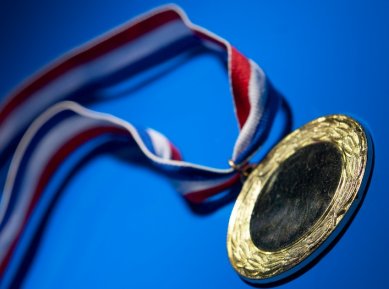The Gottfried Wilhelm Leibniz Prize is the highest honor in the German research landscape and is awarded by the Deutsche Forschungsgemeinschaft (DFG, German Research Foundation). This year, ten outstanding researchers were chosen from 134 nominees. Three of the prizewinners are from the natural sciences, three from the humanities and social sciences, two from life sciences, and two from engineering. Each honoree will receive 2.5 million EUR to fund further research.
The following researchers received the 2017 Gottfried Wilhelm Leibniz Prize:
- Lutz Ackermann, Organic Molecular Chemistry
Institute of Organic and Biomolecular Chemistry, University of GöttingenAckermann’s research is focused on the catalytic activation of carbon-hydrogen bonds. He has developed methods that allow the low-impact manufacturing of important chemical products, including active substances, agrochemicals, and fine chemicals.
- Beatrice Gründler, Arabic Studies
Seminar for Semitic and Arabic Studies, Free University of BerlinGründler studies the diversity of voices in Arabic poetry and culture. She has developed a complex media history of the Arab world, from the introduction of paper to book printing and beyond.
- Ralph Hertwig, Cognitive Psychology
Center for Adaptive Rationality, Max Planck Institute for Human Development, BerlinHertwig’s research is concerned with the psychology of human judgment and decision-making. He has expanded the understanding of the possibilities and limitations of human rationality and of the strategies which humans use to make decisions and organize their actions.
- Karl-Peter Hopfner, Structural Molecular Biology
Department of Biochemistry – Gene Center, University of Munich (LMU)Hopfner works in the fields of structural molecular biology and genome biology. He has made pioneering contributions to the field of DNA repair and the cellular detection of foreign nucleic acids with a focus on the molecular mechanisms of multiprotein complexes.
- Frank Jülicher, Theory of Biological Physics
Max Planck Institute for the Physics of Complex Systems, DresdenJülicher’s research is focused on identifying universal physical principles in the complex world of living matter. He has formulated a general hydrodynamic theory of active matter and contributed to the understanding of cell self-organization in tissue.
- Lutz Mädler, Mechanical Process Engineering
Stiftung Institut für Werkstofftechnik (IWT) and Department of Production Engineering, University of BremenMädler has performed pioneering work in the targeted reactive formation of nanoparticles in the gas phase and their effect on living matter. He has developed a variant of flame spray pyrolysis for the cost-effective synthesis of nanoparticles, which involves the thermochemical splitting of organic compounds.
- Britta Nestler, Materials Science
Institute for Applied Materials – Computational Materials Science, Karlsruhe Institute of Technology (KIT)Nestler’s research is focused on computer-assisted materials research and the development of new material models. She has achieved a new quality of microstructure representation in the thermomechanical simulation of materials. For example, her calculations are used to predict the spread of cracks in materials such as brake discs and help to extend their lifetime.
- Joachim P. Spatz, Biophysics
Max Planck Institute for Intelligent Systems, Stuttgart, and Institute of Physical Chemistry, University of HeidelbergSpatz works at the boundaries of materials sciences and cell biophysics. His research is concerned with cell adhesion, and he was able to explain how the molecular mechanism of collective cell migration works in wound healing.
- Anne Storch, African Studies
Institute for African Studies and Egyptology, University of CologneStorch’s studies have shown how linguistically-based analyses can be used to develop a cultural-anthropological understanding of contemporary Africa. For example, she studied taboos and secret languages in central Africa. Her case studies have become internationally significant model studies for a modern, self-critical approach to African Studies.
- Jörg Vogel, Medical Microbiology
Institute for Molecular Infection Biology, University of WürzburgVogel studies regulatory RNA molecules in infection biology. He has discovered how small regulatory RNA molecules control protein synthesis and the breakdown of RNA, which has contributed to the development of new methods for gene therapy. Vogel co-discovered tracrRNA (trans-activating RNA), which made the application of the CRISPR/Cas9 system possible.
Recent Publications by the Recipients
- Synergistic Heterobimetallic Manifold for Expedient Manganese(I)-Catalyzed C−H Cyanation,
Weiping Liu, Sven C. Richter, Ruhuai Mei, Milica Feldt, Lutz Ackermann,
Chem. Eur. J. 2016, 22, 17958–17961.
DOI: 10.1002/chem.201604621 - “That You Be Brought Near.” Union beyond the Grave in the Arabic Literary Tradition,
Beatrice Gründler,
in Love after Death: Concepts of Posthumous Love in Medieval and Early Modern Europe, DeGruyter, 2014.
ISBN: 978-3-05-006529-8 - Adolescents display distinctive tolerance to ambiguity and to uncertainty during risky decision making,
Wouter van den Bos, Ralph Hertwig,
Sci. Rep. 2017, 7, 40962.
DOI: 10.1038/srep40962 - CD19-specific triplebody SPM-1 engages NK and γδ T cells for rapid and efficient lysis of malignant B-lymphoid cells,
Christian B. Schiller, Todd A. Braciak, Nadja C. Fenn, Ursula J. E. Seidel, Claudia C. Roskopf, Sarah Wildenhain, Annemarie Honegger, Ingo A. Schubert, Alexandra Schele, Kerstin Lämmermann, Georg H. Fey, Uwe Jacob, Peter Lang, Karl-Peter Hopfner, Fuat S. Oduncu,
Oncotarget 2016.
DOI: 10.18632/oncotarget.13110 - Curvature regulation of the ciliary beat through axonemal twist,
Pablo Sartori, Veikko F. Geyer, Jonathon Howard, Frank Jülicher,
Phys. Rev. E 2016.
DOI: 10.1103/physreve.94.042426 - Safe-by-Design CuO Nanoparticles via Fe-Doping, Cu–O Bond Length Variation, and Biological Assessment in Cells and Zebrafish Embryos,
Hendrik Naatz, Sijie Lin, Ruibin Li, Wen Jiang, Zhaoxia Ji, Chong Hyun Chang, Jan Köser, Jorg Thöming, Tian Xia, Andre E. Nel, Lutz Mädler, Suman Pokhrel,
ACS Nano 2017, 11, 501–515.
DOI: 10.1021/acsnano.6b06495 - Phase-field simulation of the microstructure evolution in the eutectic NiAl-34Cr system,
Michael Kellner, Ioannis Sprenger, Philipp Steinmetz, Johannes Hötzer, Britta Nestler, Martin Heilmaier,
Comput. Mater. Sci. 2017, 128, 379–387.
DOI: 10.1016/j.commatsci.2016.11.049 - Getting a grip on collective cell migration,
Tamal Das, Joachim P. Spatz,
Nat. Cell Biol. 2016, 18, 1265–1267.
DOI: 10.1038/ncb3447 - A Grammar of Luwo: An anthropological approach,
Anne Storch,
John Benjamins, 2014.
ISBN: 978-90-272-0295-6 - The target spectrum of SdsR small RNA in Salmonella,
Kathrin S. Fröhlich, Katharina Haneke, Kai Papenfort, Jörg Vogel,
Nucleic Acids Res. 2016.
DOI: 10.1093/nar/gkw632



